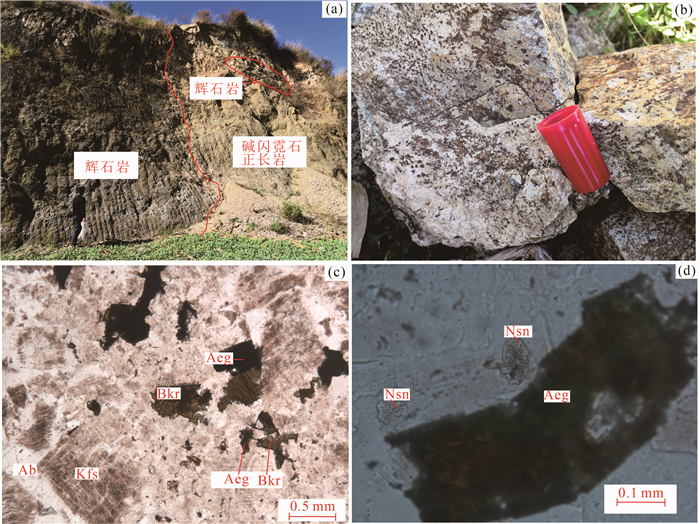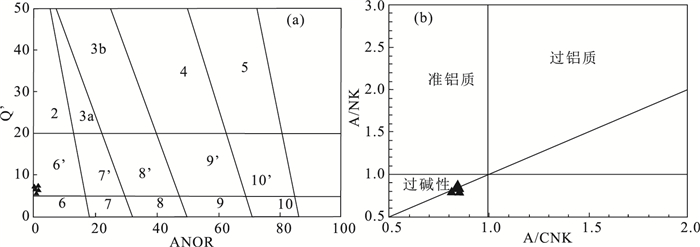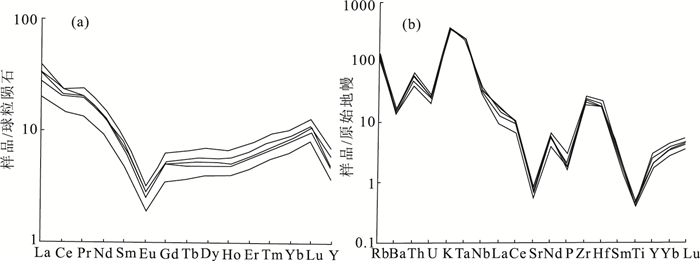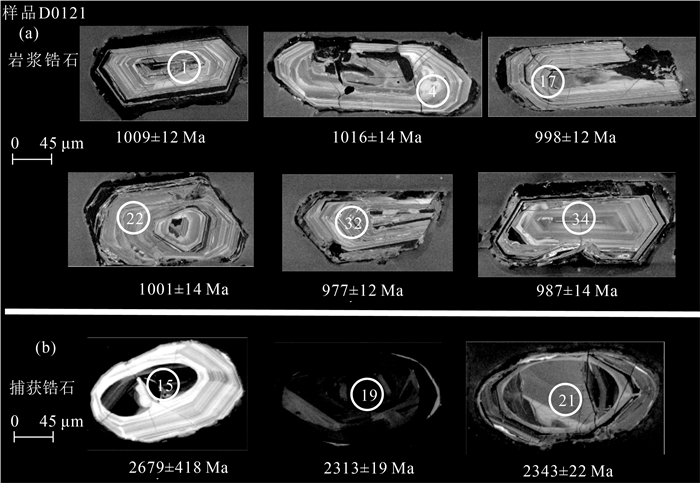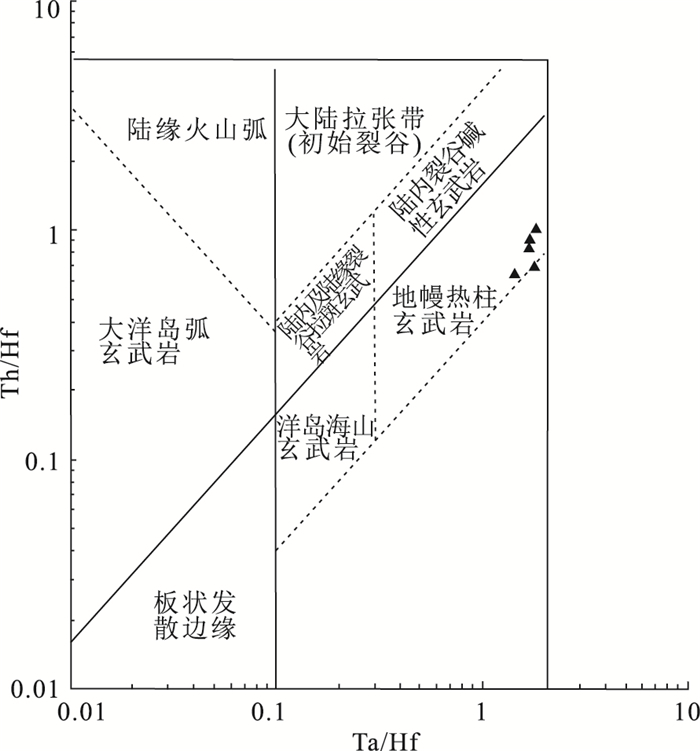The discovery of Late Mesoproterozoic alkali hornblende-aegirite syenite in E'shan area of central Yunnan and its constraints on Greenwell orogeny
-
摘要:
碱性岩通常形成于岩石圈拉张环境,其源于深部地幔物质的部分熔融,是深部地球动力学过程在地壳中的记录,也是探究地球深部物质组成、动力学过程及物理化学环境的良好对象。1:5万区域地质调查在峨山县甸中地区新发现一个正长岩岩体,岩性为碱闪霓石正长岩。系统的研究表明,碱闪霓石正长岩富硅(SiO2=67.40%~67.79%)、富碱(Na2O+K2O=12.50%~12.73%)、贫镁(MgO=0.10%~0.28%),K2O/Na2O=0.75~0.80,属一套钠质碱性岩系列(大西洋型)。岩石富集K、Rb等大离子亲石元素及Ta、Zr、Hf等高场强元素,而亏损Ti、P、U等高场强元素及Sr、Ba等大离子亲石元素。稀土元素配分曲线也较特殊,轻稀土元素向右陡倾,(La/Sm)N=3.61~4.79,重稀土元素向左缓倾,(Gd/Yb)N=0.53~0.62;具有中等程度的负Eu异常及弱负Ce异常,δEu=0.41~0.43,δCe=0.74~0.88,暗示岩浆可能形成于较高的氧逸度环境,总体上具有亏损中稀土元素的特点。LA-ICP-MS锆石U-Pb年龄为1007±10 Ma(MSWD=2.3,n=21),属中元古代末期,为扬子板块上已知形成时代最早的碱性岩体,限定了滇中地区格林威尔造山运动结束的时限。在Th/Hf-Ta/Hf图解上,样品均落入地幔热柱玄武岩区,暗示该碱性岩体可能为地幔柱成因,岩浆基本上未受到陆壳物质的混染,主体上可能属下地幔石榴子石橄榄岩的低程度部分熔融的产物;岩浆上升过程中可能与上地幔尖晶石橄榄岩发生了同化混染,重稀土元素含量快速升高;亏损中稀土元素、富Nb等特点暗示尖晶石地幔橄榄岩可能经历过俯冲流体的交代及中等程度的部分熔融。本次发现的碱闪霓石正长岩体应是格林威尔造山挤压作用向伸展作用转变的产物。
Abstract:Alkaline rocks are usually formed in the lithosphere stretching environment, which is derived from the partial melting of deep mantle material.As a record of deep geodynamic processes in the earth's crust, it is a good exploration of the deep matter composition, dynamic process and physical and chemical environment of the earth. In the 1:50000 regional geological survey, a syenite rock mass was newly discovered in the Dianzhong area of E'shan County, and its lithology is alkali homblende-aegirite-syenite.Systematic studies show that alkali hornblende-aegirite syenite rich in silicon (SiO2=67.40%~67.79%) and alkali (Na2O+K2O=12.50%~12.73%), depleted in magnesium (MgO=0.10%~0.28%) and K2O/Na2O=0.75~0.80, is a set of sodium alkaline rock series (Atlantic type).It is rich in large ion lithophile elements such as K and Rb, and high field strength elements such as Ta, Zr, and Hf, while depleted in high field strength elements such as Ti, P and U as well as large ion lithophile element, such as Sr, Ba.The rare earth distribution curve is also special, the light rare earth element is steeply inclined to the right, (La/Sm) N=3.61~4.79, and the heavy rare earth element is gently inclined to the left, (Ga/Yb) N=0.53~0.62.The moderately negative Eu anomaly and weak negative Ce anomaly (δEu=0.41~0.43, δCe=0.74~0.88) suggest that the magma may be formed in a higher oxygen fugacity environment and generally has the characteristics of depleted middle rare earth elements.LA-ICP-MS zircon U-Pb age is 1007±10 Ma (MSWD=2.3, n=21), which belongs to the end of the Middle Proterozoic.It is the earliest alkaline pluton formed on the Yangtze plate, which defines the time limit for the end of the Greenville Orogenic Movement in Central Yunnan Province.On the Th/Hf-Ta/Hf diagram, the samples fell into the "Mantle Hot Pillar Basalt" area, suggesting that the pluton might be the cause of the mantle plume, indicating that the magma is basically not contaminated by the continental crust, and the pluton might be the product of low partial melting of lower mantle garnet peridotite.During magma rise, it might be assimilated and mixed with the upper mantle spinel peridotite, and the content of heavy rare earth elements increases rapidly.The characteristics of depleted middle rare earth elements and enriched Nb compositions suggest that the mantle spinel peridotite might have experienced the metasomatism of subduction fluid and moderate partial melting.The alkali hornblende-aegirite syenite found here is the product of the conversion from Greenville Orogenic compression to extension.
-
扬子板块西缘的元古宙构造-岩浆活动较强烈,出露大量的元古宙侵入岩,该期侵入岩以花岗岩类为主,含少量基性-超基性岩[1-6],岩浆活动主要集中在晋宁期。由于其形成的构造环境对研究扬子板块大地构造格局和形成演化及Rodinia超大陆的恢复重建具有重要意义,受到广泛关注。大量元古宙岩浆岩成因及热源研究结果表明,扬子板块周缘经历了早期大洋板片俯冲作用(1160~930 Ma)和晚期大规模陆缘裂解(830~635 Ma)[1-6]。近年,国内不断有中元古代末期岩浆活动及格林威尔造山运动的报道[7-8],代表中国南方中元古代晚期—新元古代早期Rodinia超大陆聚合过程;而格林威尔运动之后,相较于稳定的克拉通东南缘,扬子板块西缘一直处于活动大陆边缘构造背景,且存在与Rodinia超大陆裂解事件相适应的由挤压构造到伸展构造体制转换的过程[9-14],但由于未找到直接反映该过程的证据,使该地区的构造动力学背景和机制认识较薄弱。本次选择最新发现的滇中峨山县甸中碱闪霓石正长岩体为研究对象,开展系统的LA-ICP-MS锆石U-Pb年代学、岩石学和地球化学研究,并探讨其侵位时代、岩石成因、物质来源和构造背景。甸中碱闪霓石正长岩体记录了扬子板块西缘中元古代末期(约1000 Ma)挤压作用向伸展作用转换的过程,为Rodinia超大陆在扬子板块的构造体制转换提供了关键性证据,也为扬子板块西缘中元古代构造-岩浆活动提供了新的约束。
1. 地质背景
研究区位于滇中峨山县甸中地区,扬子陆块区之上扬子古陆块的康滇基底断隆带,地层区划隶属于华南地层大区扬子地层区康滇地层分区的昆明地层小区(图 1)。研究区出露地层有中元古界昆阳群黑山头组(Pt2hs)、富良棚组(Pt2f)、大龙口组(Pt2d)、美党组(Pt2m),上三叠统干海子组(T3g)、舍资组(T3s)及侏罗系禄丰群(JL)(图 1)。中元古界昆阳群为一套浅变质的陆源碎屑-碳酸盐岩-火山岩建造;上三叠统干海子组为一套河湖相含煤碎屑岩建造,舍资组为一套湖泊砂岩-粉砂岩组合;侏罗系禄丰群为一套潮湿-干旱气候环境的红色碎屑岩建造①。
2. 样品采集及测试
2.1 样品采集
本次研究的样品采自易门-罗茨断裂以东,地点位于峨山县甸中镇大龙潭乡(图 1),地理坐标为东经102°07′02″、北纬24°25′15″。行政区划属甸中镇大龙潭乡管辖。甸中碱闪霓石正长岩体呈岩株状产出,出露面积约2.5 km2,被后期的辉石岩岩枝侵入,野外侵入界面清楚,中部被北北西向断裂切割,岩体岩性为浅灰色细粒碱闪霓石正长岩,整个岩体由中心至边部矿物颗粒由中粒变为细粒。岩体侵入昆阳群大龙口组碳酸盐岩中(图 1),围岩普遍角岩化,岩石受后期构造影响仅发生碎裂岩化、绢云母化。采集的较新鲜浅灰色碱闪霓石正长岩(D0121),主要由钾长石(80%)、钠-更长石(15%)、霓石(4%)和碱性闪石(1%)组成,含少量黝方石、榍石、磷灰石(0~2%)。岩石具似斑状细粒半自形粒状结构,主要由细粒半自形粒状钾长石组成(少量钾长石颗粒粒度较粗大,构成似斑晶),含少量碱性暗色矿物及钠-更长石。碱性暗色矿物以霓石为主,少部分可能为碱性闪石类矿物。岩石中浅色矿物自形程度较暗色矿物好,反映暗色矿物结晶顺序较浅色矿物晚,其结晶顺序为:钾长石-斜长石-碱性暗色矿物,符合多数碱性岩的矿物结晶顺序特征。其中,钾长石半自形板状,粒径为0.3~1 mm,部分颗粒格子双晶,为微斜长石,部分具条纹结构,为条纹长石。粒径多在细粒范围内,少部分粒径较粗大,构成似斑晶。少部分颗粒见成分(钾长石-钠长石)环带构造。普遍见钠长石交代现象,边缘具钠长石净边结构。钠-更长石粒径为0.1~1 mm,沿钾长石间隙充填、交代,其内普遍见斑块状钾长石残余。霓石粒径为0.1~5 mm,主要呈他形粒状,少部分呈半自形柱状,具辉石式解理,干涉色被本身颜色掩盖,部分颗粒因颜色差异显示环带状构造,部分颗粒具榍石反应边。碱性闪石粒径为0.5~0.8 mm,褐黄色,具闪石式解理和绿色霓石反应边。样品手标本及镜下特征见图 2。
2.2 样品测试
碱闪霓石正长岩(D0122)锆石单矿物分选在南京宏创地质勘查技术服务有限公司实验室完成。原岩样品粉碎成200目的粉末,淘洗后除去轻矿物,将得到的重砂部分经电磁选后得到含少量杂质的锆石样品,最后在双目镜下挑选出锆石晶体,选择晶形较好、无裂隙的锆石颗粒(部分具磨蚀特征),制作成环氧树脂样品靶,打磨样品靶,使锆石的中心部位暴露出来,然后进行抛光。拍摄锆石颗粒的反射光、透射光、阴极发光(CL)图像和U-Pb同位素测定需根据其特点选取合适的颗粒及区域。
锆石U-Pb同位素定年在湖北省地质实验室测试中心重点实验室利用LA-ICP-MS分析完成。测试仪器采用由美国Coherent Inc公司生产的GeoLasPro全自动版193 nm ArF准分子激光剥蚀系统(LA)和美国Agilent公司生产的7700X型电感耦合等离子体质谱仪(ICP-MS)联用构成的激光剥蚀电感耦合等离子体质谱分析系统(LA-ICP-MS)。激光剥蚀系统配置了由澳大利亚国立大学开发研制的匀化器,由10根长度不同的细PV管组成,激光剥蚀产生的细小粉末样品通过匀化器装置后,因通过长短不同的管道所需的时间略不同而使样品脉冲信号得到平滑,从而有效降低激光脉冲剥蚀样品而产生的信号波动[15-16]。锆石微量元素含量利用NIST610作为外标,Si作为内标进行定量计算。锆石U-Pb定年分析采用锆石标准年龄物质91500作为外标进行同位素分馏校正,每分析6~8个样品点分析2次91500标样。样品测试时,背景信号采集10 s,样品剥蚀40 s,管路吹扫10 s,信号采集时间总共为60 s。样品的同位素比值和元素含量采用ICP MSDataCal 9.0进行处理分析,年龄加权平均值的计算及锆石年龄谐和图的绘制采用Isoplot 3.0[17-19]完成。采用206Pb/238U年龄,其加权平均值的误差为2σ,206Pb/238U平均年龄误差为95%置信度。
选择5件岩石样品在武汉上谱分析科技有限公司进行主量、稀土和微量元素分析。样品磨碎至200目。主量元素使用X-射线荧光光谱仪(XRF-1500)法测试。用0.6 g样品和6 g四硼酸锂制成的玻璃片在ShimadzuXRF-1500上测定氧化物的质量分数值,精度优于2%~3%。微量及稀土元素利用酸溶法制备样品,使用ICP-MS(ElementⅡ)测试,分析精度符合GSR-1和GSR-2国家标准,当元素质量分数值大于10×10-6时,精度优于5%,当质量分数值小于10×10-6时,精度优于10%。
3. 岩石地球化学特征
3.1 主量元素
甸中正长岩岩体主体为浅灰色碱闪霓石正长岩,主量元素含量见表 1。5件样品的SiO2含量为67.40%~67.79%,K2O+Na2O为12.50%~12.73%,MgO为0.10%~0.28%,ΣFeO为2.39%~2.72%,Al2O3为15.72%~16.11%,具有显著的富碱、贫镁、贫铁的特点;A/CNK=0.85~0.88,平均0.87;K2O/Na2O=0.75~0.79,属钠质碱性岩系列,即大西洋型碱性岩。在SiO2-alk图解中,样品点均位于碱性岩区(图略);在CIPW标准矿物组合中出现了少量石英、透辉石、紫苏辉石分子,未出现磁铁矿、刚玉、钙长石分子;在ANOR-Q’分类图解(图 3-a)中,样品点均落入石英正长岩区域(6’区),与实际矿物命名有一定差异,可能是标准矿物与实际矿物种类之间的差异造成的。5件样品的A/CNK值为0.85~0.88,在A/CNK-A/NK图解(图 3-b)中均落入过碱性岩区,显示了明显的碱性岩特点。
表 1 碱闪霓石正长岩主量、微量和稀土元素分析结果Table 1. Major, trace element and REE compositions of alkali hornblende-aegirite syenite样品编号 D0121-1 D0121-2 D0121-3 D0121-4 D0121-5 样品编号 D0121-1 D0121-2 D0121-3 D0121-4 D0121-5 SiO2 67.79 67.77 67.64 67.8 68.03 Tb 0.23 0.25 0.18 0.26 0.32 TiO2 0.09 0.08 0.08 0.09 0.09 Dy 1.61 1.71 1.29 1.89 2.30 Al2O3 15.99 15.78 16.17 15.81 16.01 Ho 0.35 0.36 0.29 0.42 0.49 Fe2O3 1.44 1.65 1.55 1.62 1.48 Er 1.19 1.24 0.98 1.41 1.67 FeO 1.10 1.24 1.19 1.21 1.14 Tm 0.22 0.24 0.19 0.27 0.31 MnO 0.10 0.10 0.08 0.11 0.11 Yb 1.74 1.83 1.41 1.97 2.27 MgO 0.28 0.10 0.20 0.11 0.10 Lu 0.33 0.36 0.28 0.37 0.43 CaO 0.53 0.38 0.42 0.36 0.40 Y 9.07 9.51 7.34 11.6 13.8 Na2O 7.02 7.11 7.16 7.15 7.16 Rb 100.2 87.9 81.0 98.5 98.1 K2O 5.51 5.66 5.39 5.61 5.39 Ba 87.1 94.2 93.5 105.2 116.6 P2O5 0.07 0.03 0.04 0.03 0.04 Th 4.38 5.24 3.37 5.02 5.9 La 10.2 8.62 6.18 10.4 11.9 U 0.52 0.5 0.43 0.55 0.59 Ce 18.7 16.1 11.9 17.0 18.6 Nb 28.8 22.4 21.3 25.1 23.8 Pr 2.44 2.39 1.65 2.49 2.86 Ta 10.0 9.7 9.57 9.84 9.74 Nd 8.09 8.17 5.52 8.23 9.45 Hf 7.57 6.03 5.48 6.39 5.76 Sm 1.34 1.50 0.94 1.41 1.65 Sr 11.2 15.7 16.3 15.8 16.4 Eu 0.18 0.21 0.14 0.20 0.23 Zr 317.7 230.3 233.6 283.8 266.5 Gd 1.34 1.38 0.93 1.37 1.63 A/CNK 0.87 0.85 0.88 0.86 0.87 注:主量元素含量单位为%,微量和稀土元素含量单位为10-6;主量元素原始分析数据首先按11项氧化物进行标准化,然后按里特曼法进行了全铁调整;A/CNK=Al2O3/(CaO+Na2O+K2O) ![]() 图 3 碱闪霓石正长岩ANOR-Q′(a) 及A/CNK-A/NK (b) 图解[20]2—碱长花岗岩;3a—正长花岗岩;3b—二长花岗岩;4—花岗闪长岩;5—英云闪长岩;6’—石英碱长正长岩;7’—石英正长岩;8’—石英二长岩;9’—石英二长闪长岩、石英二长辉长岩;10’—石英闪长岩、石英辉长岩、石英斜长岩;6—碱长正长岩;7—正长岩;8—二长岩;9—二长闪长岩、二长辉长岩;10—闪长岩、辉长岩、斜长岩;Q′=Q/(Q+Or+Ab+An)×100; ANOR=An/(Or+An)×100Figure 3. ANOR-Q′ (a) and A/CNK-A/NK (b) diagrams of alkali hornblende-aegirite syenite
图 3 碱闪霓石正长岩ANOR-Q′(a) 及A/CNK-A/NK (b) 图解[20]2—碱长花岗岩;3a—正长花岗岩;3b—二长花岗岩;4—花岗闪长岩;5—英云闪长岩;6’—石英碱长正长岩;7’—石英正长岩;8’—石英二长岩;9’—石英二长闪长岩、石英二长辉长岩;10’—石英闪长岩、石英辉长岩、石英斜长岩;6—碱长正长岩;7—正长岩;8—二长岩;9—二长闪长岩、二长辉长岩;10—闪长岩、辉长岩、斜长岩;Q′=Q/(Q+Or+Ab+An)×100; ANOR=An/(Or+An)×100Figure 3. ANOR-Q′ (a) and A/CNK-A/NK (b) diagrams of alkali hornblende-aegirite syenite3.2 稀土元素
碱闪霓石正长岩的稀土元素含量如表 1所示。其稀土元素总量ΣREE=39.22×10-6~67.91×10-6,δEu=0.41~0.46,平均值为0.43,显示了中等强度的负Eu异常;δCe=0.74~0.88,平均值为0.82,表明岩浆形成于较高的氧逸度环境。该岩体的稀土元素配分模式(图 4-a)较少见,轻稀土元素分馏较强烈,曲线向右陡倾,(La/Sm)N=3.61~4.79,平均为4.34,而重稀土元素部分向左缓倾,(Gd/Yb)N=0.53~0.61,平均值为0.58,总体上显示了中稀土元素亏损的特点。
![]() 图 4 碱闪霓石正长岩球粒陨石标准化稀土元素配分模式图(a) 及原始地幔标准化微量元素蛛网图(b)(球粒陨石和原始地幔标准化数据据参考文献[21])Figure 4. Chondrite-normalized REE patterns (a) and primitive mantle-normalized diagrams for trace elements (b) of alkali hornblende-aegirite syenite
图 4 碱闪霓石正长岩球粒陨石标准化稀土元素配分模式图(a) 及原始地幔标准化微量元素蛛网图(b)(球粒陨石和原始地幔标准化数据据参考文献[21])Figure 4. Chondrite-normalized REE patterns (a) and primitive mantle-normalized diagrams for trace elements (b) of alkali hornblende-aegirite syenite3.3 微量元素
碱闪霓石正长岩的微量元素含量如表 1所示。5件样品均显示了异常低的Sr、Ni、Cr、Co等含量及较高的Nb含量;在微量元素比值蛛网图(图 4-b)上,5件样品具有非常相似的微量元素分布模型,表现为Rb、K等大离子亲石元素(LILE)及Th、Ta、Zr、Hf等高场强元素(HSFE)的明显正异常,同时又显示了Sr、Ba等大离子亲石元素及U、P、Ti等高场强元素的明显亏损。这些相互矛盾的特点暗示,岩浆的源区或形成过程可能具有特殊性。5件样品的Nb含量为21.3×10-6~28.8×10-6,明显的富Nb特点暗示,岩浆源区可能受到了俯冲流体的交代作用。
4. 锆石U-Pb年龄
本次用于锆石U-Pb年龄测试的样品采样位置见图 1,样品分析数据见表 2。
表 2 碱闪霓石正长岩(D0121)LA-ICP-MS锆石U-Th-Pb年龄Table 2. LA-ICP-MS zircon U-Th-Pb age data of alkali hornblende-aegirite syenite (D0121)测点号 元素含量/10-6 同位素比值 U-Pb年龄/Ma 谐和度 Th/U 采用年龄/Ma Th U 207Pb/206Pb 1σ 207Pb/235U 1σ 206Pb/238U 1σ 207Pb/206Pb 1σ 207Pb/235U 1σ 206Pb/238U 1σ 1 191.4 183.4 0.049 0.0013 0.2808 0.0084 0.0416 0.0008 150 65 251 7 263 5 95% 1 263 2 174.8 485 0.0709 0.001 1.6719 0.0311 0.1708 0.0026 954 30 998 12 1016 14 98% 0.4 1016 3 54.9 302.4 0.0711 0.0008 1.6647 0.0262 0.1695 0.0022 961 8 995 10 1009 12 98% 0.2 1009 4 36.6 60.2 0.0712 0.0017 1.7152 0.0397 0.1755 0.003 963 44 1014 15 1043 16 97% 0.6 1043 5 54.3 248.3 0.0716 0.0009 1.7204 0.0302 0.1741 0.0026 973 25 1016 11 1035 14 98% 0.2 1035 6 205.4 446.2 0.0724 0.0018 1.6908 0.0478 0.1687 0.0026 998 54 1005 18 1005 14 99% 0.5 1005 7 109.8 428.2 0.0727 0.0009 1.688 0.0329 0.168 0.0025 1006 21 1004 12 1001 14 99% 0.3 1001 8 315.8 515.4 0.0728 0.0012 1.7908 0.0392 0.1782 0.0032 1009 33 1042 14 1057 18 98% 0.6 1057 9 124.7 363.5 0.0725 0.0009 1.7067 0.0342 0.1707 0.0028 1011 27 1011 13 1016 16 99% 0.3 1016 10 248.4 650.5 0.0731 0.0009 1.6514 0.0304 0.1629 0.0022 1017 25 990 12 973 12 98% 0.4 973 11 62.7 207.3 0.0736 0.0011 1.7945 0.0421 0.1761 0.0033 1031 31 1043 15 1046 18 99% 0.3 1046 12 190.7 549.6 0.0738 0.0008 1.7082 0.0275 0.1674 0.0022 1035 22 1012 10 998 12 98% 0.3 998 13 101.7 623.3 0.0744 0.001 1.699 0.0304 0.1654 0.0025 1054 24 1008 11 987 14 97% 0.2 987 14 53.2 80.2 0.0747 0.0018 1.7521 0.0426 0.1694 0.0028 1059 47 1028 16 1009 15 98% 0.7 1009 15 57.6 100.8 0.0748 0.0013 1.7566 0.0363 0.1701 0.0027 1065 34 1030 13 1013 15 98% 0.6 1013 16 39.9 103.6 0.0758 0.0017 1.7906 0.0461 0.1711 0.003 1100 51 1042 17 1018 16 97% 0.4 1018 17 125.9 730.6 0.0765 0.0011 1.7272 0.0277 0.1637 0.0022 1107 32 1019 10 977 12 95% 0.2 977 18 296.7 485.3 0.0765 0.0014 1.4131 0.0355 0.1336 0.0026 1109 37 894 15 809 15 89% 0.6 809 19 413.8 919.7 0.078 0.0009 1.8042 0.0313 0.1671 0.0023 1147 23 1047 11 996 13 95% 0.4 996 20 261.7 1214.2 0.0787 0.0012 1.8197 0.0433 0.1668 0.003 1165 31 1053 16 994 17 94% 0.2 994 21 910.1 768 0.0794 0.0011 1.8883 0.0309 0.1723 0.0023 1183 28 1077 11 1025 12 95% 1.2 1025 22 162.9 340.9 0.0806 0.0014 1.6238 0.0412 0.1475 0.0041 1211 40 979 16 887 23 90% 0.5 887 23 259.9 539 0.0821 0.0018 1.8172 0.0682 0.16 0.0046 1250 47 1052 25 957 26 90% 0.5 957 24 791.8 1407.4 0.0841 0.001 1.9624 0.0329 0.1688 0.0027 1294 23 1103 11 1005 15 90% 0.6 1005 25 76.9 134.3 0.0895 0.0014 2.7851 0.0935 0.2245 0.0068 1417 30 1352 25 1306 36 96% 0.6 1417 26 201.7 268.3 0.0977 0.0013 3.1119 0.0582 0.2302 0.0039 1583 20 1436 14 1336 20 92% 0.8 1583 27 305.1 451 0.1005 0.0012 3.5897 0.0691 0.258 0.0039 1633 22 1547 15 1480 20 95% 0.7 1633 28 236 403.4 0.1017 0.0018 3.7442 0.0857 0.2665 0.0047 1655 27 1581 18 1523 24 96% 0.6 1655 29 311.9 419.9 0.1072 0.0013 4.5104 0.0758 0.3045 0.0043 1752 21 1733 14 1713 21 98% 0.7 1752 30 110 414.8 0.1127 0.0012 4.8624 0.0793 0.3116 0.0044 1843 19 1796 14 1749 22 97% 0.3 1843 31 266.3 1038.3 0.1405 0.0019 8.2983 0.1683 0.427 0.0072 2235 24 2264 18 2292 33 98% 0.3 2235 32 159.4 889.9 0.1472 0.0016 8.5598 0.1293 0.4207 0.0057 2313 19 2292 14 2264 26 98% 0.2 2313 33 177.2 519.2 0.1497 0.0019 9.0821 0.1805 0.4381 0.0063 2343 22 2346 18 2342 28 99% 0.3 2343 34 38.3 97.3 0.1829 0.0019 12.9887 0.2095 0.5134 0.0076 2679 18 2679 15 2671 32 99% 0.4 2679 样品锆石颗粒为无色透明或浅黄色,半自形—自形,形态呈长柱状、短柱状、粒状和不规则状,粒径大小在110~180 μm之间,颗粒长宽比为1~4。在阴极发光图像(图 5)上,锆石结构明显可分为2种类型,一类锆石具核-边结构,核、边部具有环带结构(图 5-a),且Th/U≥0.2,显示岩浆成因锆石特征;另一类锆石核部具扇形结构或椭圆状结构,且有一定磨圆,没有环带结构、呈暗色区或少量环带(图 5-b),显示继承性锆石特征。选择34粒锆石进行了定年分析,所有分析点都位于谐和线上或其附近(图 6-a),其中21粒锆石数据较集中,Th/U值为0.2~2,具有典型的振荡环带,为岩浆成因,且获得了较一致的206Pb/238U年龄加权平均值1007±10 Ma(MSWD=2.3,n=21,图 6-b),说明碱闪霓石正长岩形成年龄为中元古代末期。另有10个测点打在继承性锆石核部,获得了2679~1417 Ma的继承性锆石年龄。还有3粒锆石的表面年龄为263±5 Ma、809±15 Ma及887±23 Ma,可能为后期构造热事件的年龄,前2粒锆石年龄与峨眉山地幔柱事件、导致Rodinia超大陆裂解的南华纪地幔柱事件相对应,第3粒锆石可能为混合年龄[15-19]。
5. 讨论
5.1 岩浆锆石、捕获锆石及变质锆石的指示意义
甸中正长岩岩体位于滇中中部区域,处于扬子板块西南缘,本文对岩体发育韵律环带的岩浆进行了锆石U-Pb同位素定年,结果为1007±10 Ma(MSWD=2.3,n=21),代表了甸中正长岩岩体的形成年龄,即形成于中元古代末期,为扬子板块上已知形成时代最早的碱性岩体。
“云南1:5万二街幅等四幅区域地质调查项目”①及《云南省区域地质志》(第二版,修编)②对滇中地区的前寒武纪浅变质地层进行了大量的同位素研究,将中元古界东川群之下的浅变质地层重新厘定为中太古界元江群、新太古界普渡河群、古元古界易门群[22-29]。本文在碱闪霓石正长岩中共获得了34个有效的U-Pb同位素年龄值。其中,年龄值大于1046 Ma的10颗锆石应为岩浆上升过程中捕获围岩的继承性锆石,年龄值范围为2679~1417 Ma。结合最新的区域相关同位素研究资料,笔者认为: ①1粒锆石的207Pb/206Pb年龄值为2679±18 Ma,属新太古代晚期;②3粒锆石的207Pb/206Pb年龄值为2343~2235 Ma,与岔河花岗岩2.35 Ga的锆石U-Pb年龄相当,可能是Kenorland超大陆裂解初始阶段的岩浆活动年龄[27];③1粒锆石的207Pb/206Pb年龄值为1843±19 Ma,与易门群杉木箐组时代相当,可能与Columbia超大陆的汇聚时限一致[23-25, 29];④4粒锆石的207Pb/206Pb年龄值为1752~1583 Ma,与Columbia超大陆的裂解时限大致相当[27];⑤1粒锆石的207Pb/206Pb年龄值为1417±30 Ma,与昆阳群黑山头组时代相当[30]。年龄值小于957 Ma的锆石共3粒,其中2粒锆石的206Pb/238U年龄值为887~809 Ma,与Rodinia超大陆事件有关;1粒锆石的206Pb/238U年龄值为263±5 Ma,可能代表滇中地区中二叠世发生了一期重要的构造热事件,与峨眉山地幔柱事件时代较一致。以上捕获锆石及后期热事件改造的锆石年龄,可与扬子陆块西缘重要的区域构造-热事件进行对比[28-32]。
5.2 构造环境及其对格林威尔造山的指示
扬子板块前寒武纪碱性岩报道较少,仅在秦岭造山带一带有845~711 Ma碱性正长岩的报道[33-36];滇中地区也有少量南华纪碱性岩与基性-超基性岩③、花岗岩等相伴产出[32]。大量学者[1-6, 32-36]认为,这些记录是导致Rodinia超大陆裂解的地幔柱岩浆活动在扬子板块西缘的岩石学记录。
以往的1:5万区域地质调查①②④⑤及近年来的《云南省区域地质志》(第二版、修编)②的研究表明,滇中地区存在较多约1200 Ma的格林威尔造山期花岗岩,如元江县撮科花岗岩体(1198 Ma)②、峨山县纪母白花岗岩(1336~1048 Ma)④、元谋县那别村花岗岩体(1086 Ma)⑤等,均指示格林威尔造山运动从1200 Ma已经开始,但结束时间无定论。本次发现的甸中正长岩岩体形成于伸展构造环境,地球化学与A型花岗岩相似(富碱,贫镁)[37],应为地壳伸展减薄构造背景形成,说明滇中地区格林威尔造山运动在1007 Ma已经结束,这也是目前扬子板块上已知的年代最古老的碱性岩体,暗示了扬子板块上的格林威尔造山运动在中元古代末期已经结束,从1007 Ma开始,区域地壳演化已由挤压背景转换为伸展构造背景[32-39]。
《云南省区域地质志》(第二版、修编)②的野外调查工作中,在撮科—石屏一带出露988~948 Ma的高钛-富铁辉绿岩脉(样品编号:D006、YWxhd-04),地球化学分析表明其形成伸展背景。据1:5万区域地质调查资料③⑤⑥,峨山—塔甸一带侵入到昆阳群黑山头组、大龙口组中的高钛-富铁的辉绿岩获得908 Ma的Pb模式年龄⑥。1:5万塔甸幅中的玉河寨基性-超基性杂岩体出露于甸中碱性岩体南约25 km的同一条断裂带附近,岩体侵位于昆阳群黑山头组中,尽管缺乏同位素年代学资料,但岩石地球化学特征(富碱,贫镁)与甸中碱性正长岩岩体相似,其侵位年代也可能在1000 Ma左右;以上岩体的年龄及特征,说明格林威尔造山运动在1000 Ma左右已经结束并向伸展作用转换。由此推断,本次获得的1007 Ma应为格林威尔造山作用结束的时限。
综上所述,在1000~950 Ma,扬子板块西缘的格林威尔造山运动结束后,随即发育了一套“高钛-富铁”的基性-超基性岩-碱性岩组合③。本文5件样品的Nb含量为21.3×10-6~28.8×10-6,明显的富Nb特点暗示岩浆源区可能受到俯冲流体的交代作用,与不协调的稀土元素配分模式相互印证,指向同一事实,即岩浆源区可能由于俯冲流体的交代,发生过一次中等程度的部分熔融作用(5%~7%),形成滇中地区“高钛-富铁”的基性岩岩浆。
5.3 岩浆起源及演化
近年对碱性岩的研究中,普遍认为碱性岩形成于岩石圈拉张环境,其源于深部地幔物质的部分熔融[37-40],是深部地球动力学过程在地壳中的记录,也是探究地球深部物质组成、动力学过程及物理化学环境的良好研究对象。
由于碱性岩与基性岩类有类似的岩浆源区,本次采用研究玄武岩的图解对甸中碱性岩体进行研究。在Ta/Hf-Th/Hf图解(图 7)中,甸中岩体的5件碱闪霓石正长岩样品均落入地幔热柱玄武岩区;在Nb/Yb- Th/Yb图解(图 8)中,均位于地幔阵列内,并围绕洋岛玄武岩(OIB)分布。以上图解暗示,该碱性岩体可能为地幔柱成因,岩浆基本上未受到陆壳物质的混染,主体上可能属下地幔石榴子石橄榄岩的低程度部分熔融的产物。
现代地幔柱理论认为,俯冲洋壳经部分熔融后的固态残留物在约660 km地幔过渡带中堆积,形成较冷的难熔“巨石体”。由于重力作用,这些“巨石体”将进一步下沉到核-幔边界“D”层,同时发生钙钛矿→后钙钛矿的矿物相转变,这是一个强烈的放热反应,导致下地幔及俯冲板片堆积体自身的部分熔融,引起深部高温富铁-富钛的熔融体上涌进入地幔中,形成地幔柱。同时俯冲板块将水带到核-幔边界,与铁相互作用形成FeO2,FeO2随地幔柱上升,由于减压发生分解,释放出氧气[36-43],可造成地幔中局部的高氧逸度环境。甸中岩体碱闪霓石正长岩中普遍的负Ce异常可能就是这一机制所致。
综上所述,甸中岩体碱闪霓石正长岩的原始原浆可能起源于核-幔边界的地幔柱岩浆活动,原始岩浆的部分熔融程度较低(1%~2%);随着地幔柱的上升,岩浆源区逐步向上迁移,由石榴子石地幔橄榄岩区向尖晶石地幔橄榄岩区过渡,形成“高钛-富铁”的基性岩浆。岩浆源区可能经历过中等程度的部分熔融作用,磷灰石等特别富集中稀土元素的矿物在部分熔融过程中消耗殆尽,残留的地幔橄榄岩亏损中稀土元素,由其熔出的岩浆也相对亏损中稀土元素。
6. 结论
(1) 甸中碱闪霓石正长岩的岩浆侵位时代为1007±10 Ma,形成于伸展构造背景,明显晚于滇中地区格林威尔造山期花岗岩的侵位时代,指示滇中地区格林威尔造山运动结束的时间不晚于中元古代末期。
(2) 甸中碱闪霓石正长岩体的岩石地球化学特征表明该岩体属大西洋型碱性岩,原始岩浆是起始于核-幔边界的地幔柱岩浆,岩浆上升过程中与岩石圈地幔或软流圈地幔发生相互作用,形成了异常的稀土元素配分模式及微量元素分配形式。
(3) 在甸中碱闪霓石正长岩岩浆侵位之前,岩石圈地幔或软流圈地幔发生过俯冲流体的交代作用及中等程度的部分熔融作用,证实扬子陆块西缘在中元古代晚期存在构造力学背景转换,即洋-陆俯冲转为陆内裂谷。
致谢: LA-ICP-MS锆石U-Pb同位素分析和阴极发光照相得到南京宏创地矿袁秋云及湖北省地质实验测试中心朱丹、潘诗洋的帮助,审稿专家提出了宝贵的修改意见,在此一并表示衷心感谢。 -
图 3 碱闪霓石正长岩ANOR-Q′(a) 及A/CNK-A/NK (b) 图解[20]
2—碱长花岗岩;3a—正长花岗岩;3b—二长花岗岩;4—花岗闪长岩;5—英云闪长岩;6’—石英碱长正长岩;7’—石英正长岩;8’—石英二长岩;9’—石英二长闪长岩、石英二长辉长岩;10’—石英闪长岩、石英辉长岩、石英斜长岩;6—碱长正长岩;7—正长岩;8—二长岩;9—二长闪长岩、二长辉长岩;10—闪长岩、辉长岩、斜长岩;Q′=Q/(Q+Or+Ab+An)×100; ANOR=An/(Or+An)×100
Figure 3. ANOR-Q′ (a) and A/CNK-A/NK (b) diagrams of alkali hornblende-aegirite syenite
图 4 碱闪霓石正长岩球粒陨石标准化稀土元素配分模式图(a) 及原始地幔标准化微量元素蛛网图(b)(球粒陨石和原始地幔标准化数据据参考文献[21])
Figure 4. Chondrite-normalized REE patterns (a) and primitive mantle-normalized diagrams for trace elements (b) of alkali hornblende-aegirite syenite
表 1 碱闪霓石正长岩主量、微量和稀土元素分析结果
Table 1 Major, trace element and REE compositions of alkali hornblende-aegirite syenite
样品编号 D0121-1 D0121-2 D0121-3 D0121-4 D0121-5 样品编号 D0121-1 D0121-2 D0121-3 D0121-4 D0121-5 SiO2 67.79 67.77 67.64 67.8 68.03 Tb 0.23 0.25 0.18 0.26 0.32 TiO2 0.09 0.08 0.08 0.09 0.09 Dy 1.61 1.71 1.29 1.89 2.30 Al2O3 15.99 15.78 16.17 15.81 16.01 Ho 0.35 0.36 0.29 0.42 0.49 Fe2O3 1.44 1.65 1.55 1.62 1.48 Er 1.19 1.24 0.98 1.41 1.67 FeO 1.10 1.24 1.19 1.21 1.14 Tm 0.22 0.24 0.19 0.27 0.31 MnO 0.10 0.10 0.08 0.11 0.11 Yb 1.74 1.83 1.41 1.97 2.27 MgO 0.28 0.10 0.20 0.11 0.10 Lu 0.33 0.36 0.28 0.37 0.43 CaO 0.53 0.38 0.42 0.36 0.40 Y 9.07 9.51 7.34 11.6 13.8 Na2O 7.02 7.11 7.16 7.15 7.16 Rb 100.2 87.9 81.0 98.5 98.1 K2O 5.51 5.66 5.39 5.61 5.39 Ba 87.1 94.2 93.5 105.2 116.6 P2O5 0.07 0.03 0.04 0.03 0.04 Th 4.38 5.24 3.37 5.02 5.9 La 10.2 8.62 6.18 10.4 11.9 U 0.52 0.5 0.43 0.55 0.59 Ce 18.7 16.1 11.9 17.0 18.6 Nb 28.8 22.4 21.3 25.1 23.8 Pr 2.44 2.39 1.65 2.49 2.86 Ta 10.0 9.7 9.57 9.84 9.74 Nd 8.09 8.17 5.52 8.23 9.45 Hf 7.57 6.03 5.48 6.39 5.76 Sm 1.34 1.50 0.94 1.41 1.65 Sr 11.2 15.7 16.3 15.8 16.4 Eu 0.18 0.21 0.14 0.20 0.23 Zr 317.7 230.3 233.6 283.8 266.5 Gd 1.34 1.38 0.93 1.37 1.63 A/CNK 0.87 0.85 0.88 0.86 0.87 注:主量元素含量单位为%,微量和稀土元素含量单位为10-6;主量元素原始分析数据首先按11项氧化物进行标准化,然后按里特曼法进行了全铁调整;A/CNK=Al2O3/(CaO+Na2O+K2O) 表 2 碱闪霓石正长岩(D0121)LA-ICP-MS锆石U-Th-Pb年龄
Table 2 LA-ICP-MS zircon U-Th-Pb age data of alkali hornblende-aegirite syenite (D0121)
测点号 元素含量/10-6 同位素比值 U-Pb年龄/Ma 谐和度 Th/U 采用年龄/Ma Th U 207Pb/206Pb 1σ 207Pb/235U 1σ 206Pb/238U 1σ 207Pb/206Pb 1σ 207Pb/235U 1σ 206Pb/238U 1σ 1 191.4 183.4 0.049 0.0013 0.2808 0.0084 0.0416 0.0008 150 65 251 7 263 5 95% 1 263 2 174.8 485 0.0709 0.001 1.6719 0.0311 0.1708 0.0026 954 30 998 12 1016 14 98% 0.4 1016 3 54.9 302.4 0.0711 0.0008 1.6647 0.0262 0.1695 0.0022 961 8 995 10 1009 12 98% 0.2 1009 4 36.6 60.2 0.0712 0.0017 1.7152 0.0397 0.1755 0.003 963 44 1014 15 1043 16 97% 0.6 1043 5 54.3 248.3 0.0716 0.0009 1.7204 0.0302 0.1741 0.0026 973 25 1016 11 1035 14 98% 0.2 1035 6 205.4 446.2 0.0724 0.0018 1.6908 0.0478 0.1687 0.0026 998 54 1005 18 1005 14 99% 0.5 1005 7 109.8 428.2 0.0727 0.0009 1.688 0.0329 0.168 0.0025 1006 21 1004 12 1001 14 99% 0.3 1001 8 315.8 515.4 0.0728 0.0012 1.7908 0.0392 0.1782 0.0032 1009 33 1042 14 1057 18 98% 0.6 1057 9 124.7 363.5 0.0725 0.0009 1.7067 0.0342 0.1707 0.0028 1011 27 1011 13 1016 16 99% 0.3 1016 10 248.4 650.5 0.0731 0.0009 1.6514 0.0304 0.1629 0.0022 1017 25 990 12 973 12 98% 0.4 973 11 62.7 207.3 0.0736 0.0011 1.7945 0.0421 0.1761 0.0033 1031 31 1043 15 1046 18 99% 0.3 1046 12 190.7 549.6 0.0738 0.0008 1.7082 0.0275 0.1674 0.0022 1035 22 1012 10 998 12 98% 0.3 998 13 101.7 623.3 0.0744 0.001 1.699 0.0304 0.1654 0.0025 1054 24 1008 11 987 14 97% 0.2 987 14 53.2 80.2 0.0747 0.0018 1.7521 0.0426 0.1694 0.0028 1059 47 1028 16 1009 15 98% 0.7 1009 15 57.6 100.8 0.0748 0.0013 1.7566 0.0363 0.1701 0.0027 1065 34 1030 13 1013 15 98% 0.6 1013 16 39.9 103.6 0.0758 0.0017 1.7906 0.0461 0.1711 0.003 1100 51 1042 17 1018 16 97% 0.4 1018 17 125.9 730.6 0.0765 0.0011 1.7272 0.0277 0.1637 0.0022 1107 32 1019 10 977 12 95% 0.2 977 18 296.7 485.3 0.0765 0.0014 1.4131 0.0355 0.1336 0.0026 1109 37 894 15 809 15 89% 0.6 809 19 413.8 919.7 0.078 0.0009 1.8042 0.0313 0.1671 0.0023 1147 23 1047 11 996 13 95% 0.4 996 20 261.7 1214.2 0.0787 0.0012 1.8197 0.0433 0.1668 0.003 1165 31 1053 16 994 17 94% 0.2 994 21 910.1 768 0.0794 0.0011 1.8883 0.0309 0.1723 0.0023 1183 28 1077 11 1025 12 95% 1.2 1025 22 162.9 340.9 0.0806 0.0014 1.6238 0.0412 0.1475 0.0041 1211 40 979 16 887 23 90% 0.5 887 23 259.9 539 0.0821 0.0018 1.8172 0.0682 0.16 0.0046 1250 47 1052 25 957 26 90% 0.5 957 24 791.8 1407.4 0.0841 0.001 1.9624 0.0329 0.1688 0.0027 1294 23 1103 11 1005 15 90% 0.6 1005 25 76.9 134.3 0.0895 0.0014 2.7851 0.0935 0.2245 0.0068 1417 30 1352 25 1306 36 96% 0.6 1417 26 201.7 268.3 0.0977 0.0013 3.1119 0.0582 0.2302 0.0039 1583 20 1436 14 1336 20 92% 0.8 1583 27 305.1 451 0.1005 0.0012 3.5897 0.0691 0.258 0.0039 1633 22 1547 15 1480 20 95% 0.7 1633 28 236 403.4 0.1017 0.0018 3.7442 0.0857 0.2665 0.0047 1655 27 1581 18 1523 24 96% 0.6 1655 29 311.9 419.9 0.1072 0.0013 4.5104 0.0758 0.3045 0.0043 1752 21 1733 14 1713 21 98% 0.7 1752 30 110 414.8 0.1127 0.0012 4.8624 0.0793 0.3116 0.0044 1843 19 1796 14 1749 22 97% 0.3 1843 31 266.3 1038.3 0.1405 0.0019 8.2983 0.1683 0.427 0.0072 2235 24 2264 18 2292 33 98% 0.3 2235 32 159.4 889.9 0.1472 0.0016 8.5598 0.1293 0.4207 0.0057 2313 19 2292 14 2264 26 98% 0.2 2313 33 177.2 519.2 0.1497 0.0019 9.0821 0.1805 0.4381 0.0063 2343 22 2346 18 2342 28 99% 0.3 2343 34 38.3 97.3 0.1829 0.0019 12.9887 0.2095 0.5134 0.0076 2679 18 2679 15 2671 32 99% 0.4 2679 -
裴先治, 李佐臣, 丁仨平, 等. 扬子地块西北缘轿子顶新元古代过铝质花岗岩锆石SHRIMP U-Pb年龄和岩石地球化学及其构造意义[J]. 地学前缘, 2009, 6(3): 232-249. https://www.cnki.com.cn/Article/CJFDTOTAL-DXQY200903026.htm 刘树文, 闫全人, 李秋根, 等. 扬子克拉通西缘康定杂岩中花岗质岩石的成因及其构造意义[J]. 岩石学报, 2009, 25(8): 1883-1896. https://www.cnki.com.cn/Article/CJFDTOTAL-YSXB200908015.htm 李献华, 周汉文, 李正祥, 等. 扬子块体西缘新元古代双峰式火山岩的锆石U-Pb年龄和岩石化学特征[J]. 地球化学, 2001, 30(4): 315-322. doi: 10.3321/j.issn:0379-1726.2001.04.003 李献华, 王选策, 李武显, 等. 华南新元古代玄武质岩石成因与构造意义: 从造山运动到陆内裂谷[J]. 地球化学, 2008, 37(4): 382-399. doi: 10.3321/j.issn:0379-1726.2008.04.012 黎彤, 袁怀雨, 吴胜昔. 中国花岗岩类和世界花岗岩类平均化学成分的对比研究[J]. 大地构造与成矿学, 1998, 22(1): 29-34. https://www.cnki.com.cn/Article/CJFDTOTAL-DGYK199801004.htm 凌文黎, 高山, 程建萍, 等. 扬子陆核与陆缘新元古代岩浆事件对比及其构造意义——来自黄陵和汉南侵入杂岩LA ICPMS锆石U-Pb同位素年代学的约束[J]. 岩石学报, 2006, 22(2): 387-397. https://www.cnki.com.cn/Article/CJFDTOTAL-YSXB200602011.htm 王生伟, 廖震文, 孙晓明, 等. 会东菜园子花岗岩的年龄、地球化学——扬子地台西缘格林威尔造山运动的机制探讨[J]. 地质学报, 2013, 87(1): 54-70. doi: 10.3969/j.issn.1006-0995.2013.01.014 姜勇彪, 张世红, 吴怀春, 等. 华南地块西南缘格林威尔期区域构造解析[J]. 大地构造与成矿学, 2006, 30(2): 127-135. doi: 10.3969/j.issn.1001-1552.2006.02.001 王梦玺, 王焰, 赵红军. 扬子板块北缘周庵超镁铁质岩体锆石U-Pb年龄和Hf-O同位素特征: 对源区性质和Rodinia超大陆裂解时限的约束[J]. 科学通报, 2012, 57(34): 3283-3294. https://www.cnki.com.cn/Article/CJFDTOTAL-KXTB201234009.htm 颜丹平, 周美夫, 宋鸿林, 等. 华南在Rodinia古陆中位置的讨论——扬子地块西缘变质-岩浆杂岩证据及其与Seychelles地块的对比[J]. 地学前缘, 2002, 9(4): 249-256. doi: 10.3321/j.issn:1005-2321.2002.04.004 朱维光, 刘秉光, 邓海琳, 等. 扬子地块西缘新元古代镁铁-超镁铁质岩研究进展[J]. 矿物岩石地球化学通报, 2004, 23(3): 255-264. doi: 10.3969/j.issn.1007-2802.2004.03.013 杜利林, 耿元生, 杨崇辉, 等. 扬子地台西缘新元古代TTG的厘定及其意义[J]. 岩石矿物学杂志, 2006, 25(4): 273-281. doi: 10.3969/j.issn.1000-6524.2006.04.002 李鹏春, 陈广浩, 许德如, 等. 湘东北新元古代过铝质花岗岩的岩石地球化学特征及其成因讨论[J]. 大地构造与成矿学, 2007, 31(1): 126-136. doi: 10.3969/j.issn.1001-1552.2007.01.015 赵凤清, 赵文平, 左义成, 等. 陕西汉中地区新元古代岩浆岩U-Pb年代学[J]. 地质通报, 2006, 25(3): 383-389. doi: 10.3969/j.issn.1671-2552.2006.03.007 Hu Z C, Liu Y S, Gao S, et al. A "wire" signal smoothing device for laser ablation inductively coupled plasma mass spectrometry analysis[J]. Spectrochimica Acta Part B: Atomic Spectroscopy, 2012, 78: 50-57. doi: 10.1016/j.sab.2012.09.007
刘军平, 胡绍斌, 李静, 等. 滇西云县地区团梁子岩组变质岩锆石U-Pb定年及其构造意义[J]. 地质通报, 2018, 37(11): 2079-2086. http://dzhtb.cgs.cn/gbc/ch/reader/view_abstract.aspx?file_no=20181114&flag=1 Ludwig K R. Isoplot 3.00: A Geochronological Toolkit for Microsoft Excel[J]. Berkelery: Ber keley Geochronology Center, California, 2003. http://www.researchgate.net/publication/313569312_Isoplot_300_A_Geochronological_Toolkit_for_Microsoft_Excel_Berkeley
王海然, 赵红格, 乔建新, 等. 锆石U-Pb同位素测年原理及应用[J]. 地质与资源, 2013, 22(3): 229-242. doi: 10.3969/j.issn.1671-1947.2013.03.012 吴元保, 郑永飞. 锆石成因矿物学研究及其对U-Pb年龄解释的制约[J]. 科学通报, 2004, 49(16): 1589-1604. doi: 10.3321/j.issn:0023-074X.2004.16.002 Richwood P C. Boundary lines within petrologic diagrams which use oxides of major and minor elements[J]. Lithos, 1989, 22(4): 247-263. doi: 10.1016/0024-4937(89)90028-5
Sun S S, McDonough W F. Chemical and isotope systematicas of oceanic basalts: implic-ations for mantle composition and processes[C]//Saunders A D, Norry M J. Magmatism in the Ocean Basins. Geological Society Special Publication, 1989, 42: 313-345.
李静, 刘桂春, 刘军平, 等. 滇中地区早前寒武纪地质研究进展[J]. 地质通报, 2018, 37(11): 1957-1969. http://dzhtb.cgs.cn/gbc/ch/reader/view_abstract.aspx?file_no=20181101&flag=1 刘军平, 曾文涛, 徐云飞, 等. 滇中易门地区约1.85Ga凝灰岩的厘定及其地质意义[J]. 地质通报, 2018, 37(11): 2055-2062. http://dzhtb.cgs.cn/gbc/ch/reader/view_abstract.aspx?file_no=20181111&flag=1 刘军平, 王小虎, 关学卿, 等. Columbia超大陆汇聚在扬子陆块西南缘的响应——来自热液石英脉锆石U-Pb年龄的证据[J]. 中国地质, 2021, 48(5): 1653-1654. https://www.cnki.com.cn/Article/CJFDTOTAL-DIZI202105026.htm 刘军平, 李静, 孙柏东, 等. 滇中易门地区发现化石新物种[J]. 沉积与特提斯地质, 2018, 38(1): 37-40. doi: 10.3969/j.issn.1009-3850.2018.01.004 李静, 刘军平, 孙柏东, 等. 滇中易门地区古元古界易门群亮山组多细胞生物的年代学约束[J]. 地质通报, 2018, 37(11): 2087-2098. http://dzhtb.cgs.cn/gbc/ch/reader/view_abstract.aspx?file_no=20181115&flag=1 刘军平, 曾文涛, 孙柏东, 等. 云南峨山地区东川群黑山组流纹质碎斑熔岩锆石U-Pb年龄及其地质意义[J]. 沉积与特提斯地质, 2018, 38(3): 19-25. https://www.cnki.com.cn/Article/CJFDTOTAL-TTSD201803011.htm 刘军平, 夏彩香, 孙柏东, 等. 滇中易门地区新元古代澄江组凝灰岩锆石U-Pb年龄及其地质意义[J]. 沉积与特提斯地质, 2019, 39(1): 14-21. doi: 10.3969/j.issn.1009-3850.2019.01.002 刘军平, 李静, 王根厚, 等. 扬子板块西南缘基性侵入岩锆石定年及地球化学特征——Columbia超级大陆裂解的响应[J]. 地质论评, 2020, 66(2): 350-364. https://www.cnki.com.cn/Article/CJFDTOTAL-DZLP202002009.htm 刘军平, 孙柏东, 王晓峰, 等. 滇中禄丰地区中元古代早期球颗玄武岩的锆石U-Pb年龄、地球化学特征及其大地构造意义[J]. 地质论评, 2020, 66(1): 35-51. https://www.cnki.com.cn/Article/CJFDTOTAL-DZLP202001004.htm 陆松年, 杨春亮, 李怀坤, 等. 华北古大陆与哥伦比亚超大陆[J]. 地学前缘, 2002, 9(9): 226-233. https://www.cnki.com.cn/Article/CJFDTOTAL-DXQY200204001.htm 刘军平, 孙柏东, 崔晓庄, 等. 云南安宁地区石虎山花岗岩年代学、地球化学特征和锆石Hf同位素组成及其成因[J]. 中国地质, 2020, 47(3): 693-708. https://www.cnki.com.cn/Article/CJFDTOTAL-DIZI202003011.htm 包志伟, 王强, 白国典, 等. 东秦岭方城新元古代碱性正长岩形成时代及其动力学意义[J]. 科学通报, 2008, 53(6): 684-694. doi: 10.3321/j.issn:0023-074X.2008.06.012 Chen Z, Lu S, Li H, et al. Constraining the role of the Qinling orogen in the assembly and break-up of Rodinia: Tectonic implications for Neoproterozoic granite occurrences[J]. J Asian Earth Sci., 2006, 28: 99-115. doi: 10.1016/j.jseaes.2005.03.011
卢欣祥, 董有, 尉向东, 等. 东秦岭吐雾山A型花岗岩的时代及其构造意义[J]. 科学通报, 1999, 44(9): 975-978. doi: 10.3321/j.issn:0023-074X.1999.09.018 王德滋, 赵广涛, 邱检生. 中国东部晚中生代A型花岗岩的构造制约[J]. 高校地质学报, 1995, 1(2): 13-21. https://www.cnki.com.cn/Article/CJFDTOTAL-GXDX502.001.htm 张旗, 冉皞, 李承东. A型花岗岩的实质是什么?[J]. 岩石矿物学杂志, 2012, 231(4): 621-626. doi: 10.3969/j.issn.1000-6524.2012.04.014 Mao H W, Hu Q Y, Yang L X, et al. When water meets iron at Earth's core-mantle boundary[J]. National Science Review, 2017, 4: 870-878. doi: 10.1093/nsr/nwx109
刘军平, 熊波, 李静, 等. 扬子西缘东川落雪地区元古宙地层中3890Ma锆石的发现[J]. 地质学报, 2021, 95(5): 1606-1613. doi: 10.3969/j.issn.0001-5717.2021.05.021 刘军平, 王晓峰, 王小虎, 等. 滇中甸中地区中二叠世晚期镁铁-超镁铁质岩体特征及其与峨眉地幔柱关系——来自锆石U-Pb年龄及岩石地球化学证据[J]. 地质论评, 2020, 66(5): 1284-1298. https://www.cnki.com.cn/Article/CJFDTOTAL-DZLP202005019.htm 任光明, 庞维华, 潘桂棠, 等. 扬子陆块西缘中元古代菜子园蛇绿混杂岩的厘定及其地质意义[J]. 地质通报, 2017, 36(11): 2061-2075. doi: 10.3969/j.issn.1671-2552.2017.11.016 刘军平, 宛胜, 李静, 等. 滇中易门地区古元古界易门群罗洼垤组火山岩锆石U-Pb年龄及其构造热事件[J]. 地质通报, 2021, 40(7): 1024-1032. http://dzhtb.cgs.cn/gbc/ch/reader/view_abstract.aspx?file_no=20210702&flag=1 陈海福, 何书跃, 张爱奎, 等. 东昆仑卡尔却卡地区中志留世A型花岗岩岩石成因及构造环境[J]. 地质通报, 2021, 40(8): 1380-1393. http://dzhtb.cgs.cn/gbc/ch/reader/view_abstract.aspx?file_no=20210814&flag=1 云南省地质调查院. 云南1: 5万二街、易门县等4幅区域地质调查报告. 2019. 云南省地质调查院. 《云南省区域地质志》(第二版, 修测). 2019. 云南省地质调查院. 云南1: 5万州城、米甸街等4幅区域地质调查报告. 2016. 云南省地质矿产勘查开发局. 云南1: 5万杨武幅、落水洞幅区域地质调查报告. 1998. 云南省地质调查院. 云南1: 5万下拉古、环州村等5幅区域地质调查报告. 2014. 云南省地质矿产局. 云南1: 5万塔甸幅、化念农场幅区域地质调查报告. 1990. -
期刊类型引用(3)
1. 刘建清,何利,胡志中,冉敬,陆俊泽,何佳伟. 滇东北昭通地区寒武系筇竹寺组碎屑锆石年代学和地球化学及其地质意义. 地质论评. 2025(01): 119-136 .  百度学术
百度学术
2. 何世军,杨仕潘,刘军平,吴志山,黄卫强,江化寨,周晓锋. 扬子西南缘易门地区~1.4 Ga岩浆事件的厘定及其对菜子园—易门洋演化的指示. 地质论评. 2023(06): 2375-2390 .  百度学术
百度学术
3. 李超,张杰,廖怡,汤鸿伟,安煜,屈强,陶刚,卢志友. 四川沙坝地区铁船山组流纹质凝灰熔岩岩石学、年代学特征及其铀成矿指示意义. 铀矿地质. 2022(05): 928-939 .  百度学术
百度学术
其他类型引用(0)




 下载:
下载:
